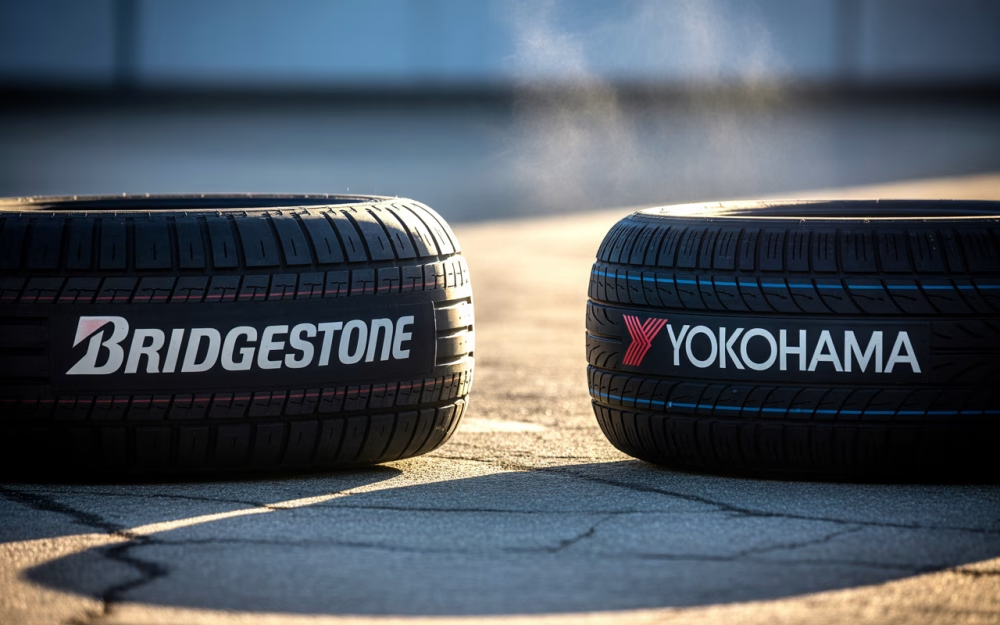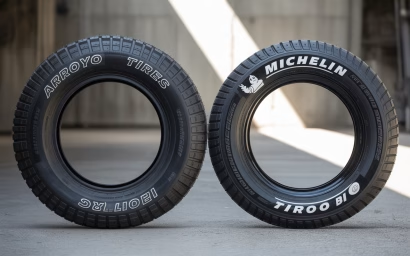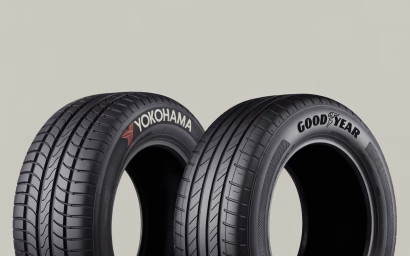When it comes to outfitting your vehicle with the perfect set of tires, two giants in the industry often come to mind: Bridgestone vs Yokohama Tires. Both of these Japanese tire manufacturers have rich histories dating back to the early 20th century and have since become global leaders in tire innovation and production. But how do they stack up against each other?
In this comprehensive comparison of Bridgestone vs Yokohama tires, we’ll take you on a journey through the strengths and unique offerings of each brand. From their storied company histories to their cutting-edge manufacturing capabilities, diverse product ranges, and commitment to quality and performance, we’ll explore what sets these tire titans apart.
Whether you’re a performance enthusiast looking for the ultimate grip on dry pavement, a daily commuter seeking comfort and durability, or an eco-conscious driver prioritizing fuel efficiency, understanding the nuances between Bridgestone and Yokohama can help you make an informed decision for your next tire purchase.
So buckle up and join us as we dive deep into the world of Bridgestone and Yokohama tires, comparing everything from their innovative technologies to their performance on the road. By the end of this post, you’ll be equipped with the knowledge to choose the right tire for your specific needs and driving style. Let’s roll into the details!
Table of Contents
Company Histories
Bridgestone Corporation
Founded in 1931 in Kurume, Japan, Bridgestone Corporation has grown from a small rubber manufacturing company into a global leader in the tire industry. Established by Shojiro Ishibashi, the company initially produced tires for bicycles and motorcycles, later expanding into tires for automobiles and trucks. Over the decades, Bridgestone has expanded its operations worldwide, with manufacturing facilities and sales networks spanning multiple continents.
Yokohama Rubber Company
Yokohama Rubber Company traces its origins back to 1917, when it was established in Yokohama, Japan, as a joint venture between Yokohama Cable Manufacturing and the B.F. Goodrich Company of the United States. Initially focused on producing rubber products for the maritime industry, Yokohama soon diversified into the production of tires for automobiles and other vehicles. Throughout its history, Yokohama has maintained a strong emphasis on innovation and technological advancements, contributing to the development of various tire technologies.
Product Ranges
Bridgestone and Yokohama offer a wide range of tire products to cater to various vehicle types and driving conditions. Both companies have a strong presence in the passenger car tire market, offering a diverse selection of tires designed for different performance needs, such as all-season, high-performance, and ultra-high-performance tires.
Bridgestone’s passenger car tire lineup includes popular models like the Ecopia for eco-friendly driving, the Turanza for a comfortable ride, and the Potenza for sports car enthusiasts. Additionally, they offer tires for light trucks, SUVs, and crossovers under the Dueler and Alenza lines.
Yokohama’s passenger car tire offerings include the Avid line for all-season performance, the Advan for high-performance driving, and the Geolandar for SUVs and light trucks. They also have a dedicated line of tires for electric vehicles, known as the BluEarth-Air EV.
Both brands have a strong presence in the commercial truck and bus tire segment, with Bridgestone’s Firestone and Bridgestone brands catering to this market, while Yokohama offers its own line of commercial truck tires.
When it comes to off-road and specialty tires, Bridgestone’s Firestone brand offers a range of tires for agricultural, mining, and construction applications, while Yokohama has a dedicated line of off-road tires for trucks, SUVs, and ATVs.
Overall, both Bridgestone and Yokohama offer a comprehensive range of tire products to meet the diverse needs of consumers, from passenger cars to commercial vehicles and specialized applications.
Manufacturing Capabilities
Bridgestone and Yokohama are two tire manufacturing giants, each with extensive production facilities and advanced technologies that allow them to produce high-quality tires on a massive scale.
Bridgestone operates numerous state-of-the-art tire plants across the globe, with major facilities in countries like Japan, United States, Mexico, and Poland. These factories are equipped with cutting-edge machinery and automation systems, enabling Bridgestone to maintain consistent quality while meeting the high demand for its tires. The company’s production capacity is immense, with the ability to manufacture millions of tires annually.
Yokohama, on the other hand, has a more concentrated manufacturing footprint, with the majority of its production facilities located in Japan. However, the company has also expanded its operations to other countries, including the Philippines, Vietnam, and Thailand. Yokohama’s factories are known for their precision engineering and stringent quality control measures, ensuring that every tire meets the company’s exacting standards.
Both companies heavily invest in research and development, constantly exploring new materials, tread designs, and manufacturing processes to enhance the performance and durability of their tires. Bridgestone has pioneered technologies such as Run-Flat tires, which allow drivers to continue driving even after a puncture, and ologic technology, which optimizes tire design for improved fuel efficiency and handling.
Yokohama, meanwhile, has developed advanced compounds like the BluEarth and GEOLANDAR technologies, which offer improved grip, reduced rolling resistance, and longer tread life. The company also employs cutting-edge simulation software and virtual testing methods to refine tire designs before physical prototyping.
In terms of production capacity, Bridgestone has a clear advantage due to its larger global footprint and higher output levels. However, Yokohama’s focus on precision engineering and advanced technologies ensures that its tires are of the highest quality, even if produced in smaller quantities.
Quality and Durability
Bridgestone and Yokohama are renowned for their commitment to producing high-quality, durable tires that can withstand the rigors of everyday driving as well as extreme conditions. Both companies employ stringent quality control measures and extensive testing procedures to ensure their tires meet the highest standards of performance and longevity.
Tire testing is a crucial aspect of the development process for both manufacturers. Bridgestone and Yokohama subject their tires to a wide range of tests, simulating various road conditions, temperatures, and driving scenarios. This includes indoor laboratory tests, outdoor proving grounds, and real-world testing on public roads. These tests evaluate factors such as treadwear, traction, handling, and resistance to environmental factors like heat, cold, and moisture.
Bridgestone and Yokohama also have rigorous quality control processes in place throughout their manufacturing facilities. These processes involve multiple inspections and checks at various stages of production to identify and eliminate any potential defects or inconsistencies. Automated systems and highly trained personnel work together to ensure that every tire meets the company’s exacting quality standards.
In terms of durability, both companies offer comprehensive warranties and treadwear ratings for their tires. Bridgestone’s tire warranties typically cover workmanship and materials for a specified period, with additional coverage for treadwear based on the specific tire model. Yokohama also provides warranties that cover manufacturing defects and treadwear, with varying levels of coverage depending on the tire line.
Treadwear ratings, expressed as a numerical value, provide an indication of a tire’s expected lifespan under normal driving conditions. Higher treadwear ratings generally indicate longer-lasting tires. Both Bridgestone and Yokohama offer tire models with varying treadwear ratings to cater to different driving needs and budgets.
Overall, Bridgestone and Yokohama have earned reputations for producing tires that deliver exceptional quality and durability, thanks to their rigorous testing protocols, stringent quality control measures, and comprehensive warranties and treadwear ratings.
Performance and Handling
Both Bridgestone and Yokohama produce tires engineered for optimal performance and handling characteristics. However, there are some key differences between the two brands’ offerings.
Bridgestone’s flagship performance tire lines, such as the Potenza and Ecopia, are renowned for their exceptional dry and wet traction. The advanced silica-enhanced tread compounds provide remarkable grip on both dry and wet surfaces, allowing for confident braking and cornering. Additionally, Bridgestone’s tire construction and design prioritize even wear and responsive handling, ensuring consistent performance throughout the tire’s lifespan.
Yokohama, on the other hand, has built a reputation for tires that excel in dry conditions. Their ADVAN line, developed in collaboration with motorsports engineers, delivers uncompromising dry grip and precise cornering capabilities. The tires’ stiff sidewalls and optimized tread patterns contribute to responsive steering and excellent stability at high speeds. However, some Yokohama performance tires may sacrifice wet traction for their exceptional dry performance.
In terms of ride comfort, Bridgestone’s technologies, such as the computer-optimized component design and advanced casing construction, provide a smooth and comfortable ride, even on performance-oriented tires. Yokohama’s performance tires, while prioritizing handling and grip, can sometimes exhibit a firmer ride quality, particularly on models designed for track use or enthusiast driving.
It’s worth noting that both brands offer a diverse range of performance tires tailored to different vehicle types and driving styles. Bridgestone’s lineup includes options for sports cars, sedans, and even SUVs, ensuring a balance between performance and comfort. Yokohama, too, has expanded its offerings to cater to various segments, including high-performance all-season tires for daily drivers seeking a blend of performance and year-round capability.
Innovative Technologies
Bridgestone and Yokohama have both pioneered innovative tire technologies to enhance performance, safety, and sustainability. Bridgestone’s patented NanoPro-Tech™ compound incorporates nano particles for improved wear resistance and fuel efficiency. Their ologic technology features an eco-friendly, energy-saving construction with a unique tread design that reduces rolling resistance. Bridgestone’s RunOnFlat tires allow temporary mobility after a puncture, eliminating the need for a spare tire.
Yokohama has developed the Advanced Insipiring Eco Technology (AIR) that uses a unique compound and tread design to improve fuel economy and wet grip performance. Their AIRTEX Advanced Polymer technology creates a more pliable tire for better traction and ride comfort. Yokohama’s HAITU run-flat tires use reinforced sidewalls to support the vehicle’s weight when deflated, providing a safer solution for temporary mobility after a puncture.
Both companies are actively pursuing eco-friendly initiatives, such as using sustainable materials and developing tires with lower rolling resistance to improve vehicle fuel efficiency and reduce carbon emissions.
Pricing and Value
When it comes to pricing and value, both Bridgestone and Yokohama offer a wide range of tire models to cater to different budgets and needs. However, there are some notable differences between the two brands.
Bridgestone is generally considered a premium tire brand, and their prices tend to be on the higher end of the market. This is because Bridgestone invests heavily in research and development, utilizing advanced technologies and high-quality materials in their tire construction. As a result, their tires often deliver superior performance, durability, and comfort, justifying the higher price point for many consumers.
On the other hand, Yokohama tires are typically more affordable than their Bridgestone counterparts. While not as premium as Bridgestone, Yokohama still offers a good balance of performance and value. Their tires are designed to provide reliable handling, traction, and longevity at a more budget-friendly price point.
When comparing competing models from the two brands, Bridgestone tires often carry a premium of 10-20% or more over their Yokohama counterparts. For example, a high-performance Bridgestone Potenza tire might cost $150-200 per tire, while a comparable Yokohama ADVAN tire could be priced around $120-170 per tire.
However, it’s important to consider the value proposition of each brand. While Bridgestone tires may be more expensive upfront, their advanced technologies, longer tread life, and superior performance could potentially offset the higher initial cost over the tire’s lifespan. Conversely, Yokohama tires offer a more affordable option for budget-conscious consumers who still desire reliable performance and quality.
Ultimately, the choice between Bridgestone and Yokohama tires will depend on individual priorities, driving needs, and budget considerations. Those seeking the ultimate in performance and longevity may be willing to invest in the premium pricing of Bridgestone, while others may find the value proposition of Yokohama’s more affordable offerings more appealing.
Original Equipment Partnerships
Bridgestone and Yokohama have secured partnerships with major vehicle manufacturers to supply original equipment (OE) tires for their vehicles. These partnerships are a testament to the quality and performance of their tires, as automakers rigorously test and evaluate tire options before selecting OE suppliers.
Bridgestone’s OE partnerships include prestigious brands like BMW, Mercedes-Benz, Porsche, and Audi in the luxury segment. They also supply tires for mainstream brands like Toyota, Honda, Nissan, and Ford. This diverse portfolio showcases Bridgestone’s ability to meet the diverse needs of different vehicle segments, from high-performance sports cars to family sedans and SUVs.
Yokohama, on the other hand, has a strong presence in the OE market for Japanese automakers. They are the OE supplier for brands like Nissan, Infiniti, Mitsubishi, and Mazda. Yokohama’s tires are also found on various models from Honda, Subaru, and Toyota. While their OE partnerships may not be as extensive as Bridgestone’s, they have a solid foothold in the Japanese automotive market.
Both companies invest heavily in research and development to create tires that meet the specific requirements of each vehicle model. This includes factors such as ride comfort, handling, noise levels, and fuel efficiency. By working closely with automakers during the vehicle development process, Bridgestone and Yokohama can optimize their tire designs to deliver the desired performance characteristics.
Motorsports Involvement
Both Bridgestone and Yokohama have a strong presence in various motorsports series, leveraging these platforms to showcase their tire technologies and performance capabilities.
Bridgestone
Bridgestone has been a major player in the world of motorsports for decades. One of their most significant involvements is as the exclusive tire supplier for the FIA Formula One World Championship since 1999. This technical partnership has allowed Bridgestone to develop cutting-edge tire compounds and constructions that can withstand the extreme demands of Formula One racing.
Additionally, Bridgestone has been the official tire partner of the FIA World Endurance Championship (WEC), including the prestigious 24 Hours of Le Mans race. This series tests the durability and performance of Bridgestone’s tires in grueling endurance racing conditions.
Bridgestone also has a strong presence in various national and international touring car racing series, such as the British Touring Car Championship (BTCC) and the Super GT series in Japan.
Yokohama
Yokohama’s motorsports involvement is equally impressive, particularly in the realm of off-road and rally racing. The company has been the official tire partner of the FIA World Rally Championship (WRC) since 2022, providing tires that can handle the diverse and challenging terrains encountered in rally events worldwide.
Yokohama has also been a prominent player in the SCORE International Off-Road Racing series, supplying tires for various classes of off-road vehicles, including trophy trucks and buggies. This involvement allows Yokohama to showcase the durability and traction capabilities of its tires in extreme off-road conditions.
Furthermore, Yokohama has a strong presence in the Dakar Rally, one of the most grueling off-road endurance races in the world. The company’s tires have been used by numerous teams competing in this legendary event, demonstrating their ability to withstand the harshest desert conditions.
Both Bridgestone and Yokohama’s involvement in various motorsports series serves as a testament to their commitment to developing high-performance, durable, and innovative tire technologies. These technical partnerships and sponsorships provide valuable real-world testing grounds, allowing the companies to continuously improve their products and stay at the forefront of tire engineering.
Customer Satisfaction
Bridgestone and Yokohama both pride themselves on delivering high levels of customer satisfaction, but there are some key differences in how they approach this goal.
When it comes to warranty claims data, Bridgestone has consistently lower rates of claims across their product lines. This suggests that Bridgestone tires experience fewer defects and premature wear issues, leading to fewer dissatisfied customers needing to file warranty claims.
In terms of consumer surveys, Bridgestone tends to rate higher than Yokohama in areas like tread life, ride comfort, and overall satisfaction. Major consumer publications and advocacy groups frequently rank Bridgestone among the top tire brands in their surveys and ratings.
Third-party rating firms like J.D. Power and Consumer Reports have also given Bridgestone an edge over Yokohama in recent years. Bridgestone has earned several awards and high rankings from these independent sources for vehicle satisfaction and product quality.
However, it’s worth noting that Yokohama still performs respectably in many customer satisfaction metrics. While they may trail Bridgestone in some areas, Yokohama owners generally report being pleased with the quality and performance of their tires.
Ultimately, Bridgestone seems to have a slight advantage when it comes to objective measures of customer satisfaction like warranty data, consumer surveys, and third-party ratings. But both brands work hard to keep their customers happy and build brand loyalty.



